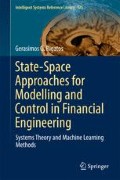Abstract
Pricing of commodities (e.g. oil, carbon, mining products, electric power, agricultural crops, etc.) is vital for the majority of transactions taking place in financial markets. A method for feedbsck control of commodities pricing dynamics is developed. The PDE model of the commodities price dynamics is shown to be equivalent to a multi-asset Black–Scholes PDE. Actually it is a diffusion process evolving in a 2D assets space, where the first asset is the commodity’s spot price and the second asset is the convenience yield. By applying semi-discretization and a finite differences scheme this multi-asset PDE is transformed into a state-space model consisting of ordinary nonlinear differential equations. For the local subsystems, into which the commodities PDE is decomposed, it becomes possible to apply boundary-based feedback control. The controller design proceeds by showing that the state-space model of the commodities PDE stands for a differentially flat system. Next, for each subsystem which is related to a nonlinear ODE, a virtual control input is computed, that can invert the subsystem’s dynamics and can eliminate the subsystem’s tracking error. From the last row of the state-space description, the control input (boundary condition) that is actually applied to the multi-factor commodities’ PDE system is found. This control input contains recursively all virtual control inputs which were computed for the individual ODE subsystems associated with the previous rows of the state-space equation. Thus, by tracing the rows of the state-space model backwards, at each iteration of the control algorithm, one can finally obtain the control input that should be applied to the commodities PDE system so as to assure that all its state variables will converge to the desirable setpoints. By showing the feasibility of such a control method it is also proven that through selected purchases and sales during the trading procedure the price of the negotiated commodities can be made to converge and stabilize at specific reference values.
Access this chapter
Tax calculation will be finalised at checkout
Purchases are for personal use only
Author information
Authors and Affiliations
Corresponding author
Rights and permissions
Copyright information
© 2017 Springer International Publishing AG
About this chapter
Cite this chapter
Rigatos, G.G. (2017). Stabilization of Commodities Pricing PDE Using Differential Flatness Theory. In: State-Space Approaches for Modelling and Control in Financial Engineering. Intelligent Systems Reference Library, vol 125. Springer, Cham. https://doi.org/10.1007/978-3-319-52866-3_14
Download citation
DOI: https://doi.org/10.1007/978-3-319-52866-3_14
Published:
Publisher Name: Springer, Cham
Print ISBN: 978-3-319-52865-6
Online ISBN: 978-3-319-52866-3
eBook Packages: EngineeringEngineering (R0)

